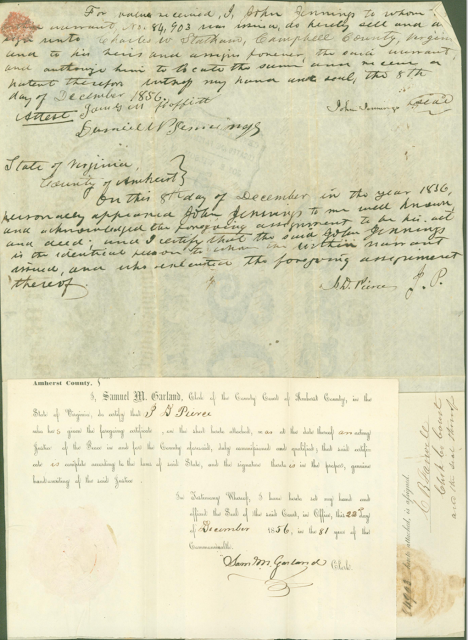From 1775 to 1855 the United States government granted bounty-land warrants for military service, primarily to encourage volunteer enlistments, but also to reward veterans for service during the Revolutionary War, the War of 1812, the Mexican War, a variety of Indian wars, Indian removals, and other military actions during the 1850s. Early warrants could only be used in military districts, principally in Ohio and several other public land states in the former Northwest Territory. Eventually, Congress expanded eligibility to include service in the Regular Army and the Navy, as well as volunteer militias. Bounty-land for military service was discontinued in 1858 and in 1863 the rights to locate and possess land ceased.
John Jennings initially applied for bounty land in 1853 and the Virginia Third Auditor's Office confirmed his service. A bounty land warrant for 40 acres was issued but was lost by an Amherst County court official and John never received it. By 1855 the bounty land laws had changed and John was entitled to 120 acres; so he applied again using a form entitled "Application of a Person Who has Had a Warrant" under the 1855 law entitled, "An act in addition to certain Acts granting Bounty Land to certain Officers and Soldiers who have been engaged in Military Service of the United States." He received his warrant certificate on 4 September 1856.
 |
| John W. Jennings, Sr.,'s bounty land warrant for 120 acres; courtesy of the National Archives and Records Administration and retrieved by Vonnie S. Zullo of Horse Soldier Military Research[1] |
John sold and assigned his warrant to Charles W. Statham of Campbell County, Virginia, on 8 December 1856. When the 1860 census was enumerated Statham's occupation was listed as land jobber. Land jobbers were speculators who purchased bounty warrants from veterans, their widows or heirs for a fraction of their true value. On the Bureau of Land Management's General Land Office website, I have found nearly 50 patents filed by Statham's agents in land offices in Arkansas, Iowa, Kansas, Louisiana, Nebraska, and Wisconsin. Since Charles W. Statham lived and died in Lynchburg, Virginia, my assumption is he later sold the land acquired under these patents.
 |
| Paperwork which assigned the land warrant to Charles W. Statham; courtesy of the National Archive and Records Administration and retrieved by Vonnie S. Zullo of Horse Soldier Military Research |
For value received, I, John Jennings, to whom [illegible] for this warrant, No. 84,903 was issued, do hereby sell and assign unto Charles W. Statham, Campbell County, Virginia, and to his heirs and assigns forever, the said warrant and authorize him to locate the same and receive a patent therefore. Witness my hand and seal, this 8th day of December 1856.
John Jennings (seal)
Attest,
James M. Proffitt
Daniel W. Jennings
State of Virginia
County of Amherst
On this 8th day of December in the year 1856, personally appeared John Jennings to me well known, and acknowledged the foregoing assignment to be his act and deed; and I certify that this said John Jennings is the identical person to whom the within warrant issued, and who executed the foregoing assignment.
[illegible] D. Pierce, Justice of the Peace
On 10 Jun 1857, the Stevens Point, Wisconsin Land Office issued a certificate for the 120 acres Charles W. Statham located in Portage County, Wisconsin. The land was located in Township 25 North, Range 7 East in Sections 32 and 33 -- T25N R7E S32 E1/2SE1/4 and T25N R7E S33 SW1/4SW1/4.
 |
| Certificate issued for 120 acres in Portage County, Wisconsin to Charles W. Statham; courtesy of National Archives and Records Administration and retrieved by Vonnie S. Zullo of Horse Soldier Research |
The land is just south of Lake du Bay, which looks to be close to geographical center of Wisconsin and nearly on the same latitude as Montreal, Canada.
 |
| Sections 32 and 33 in red; courtesy of the Bureau of Land Management |
Thank goodness John W. Jennings, Sr., was 80 years old when he received the bounty-land warrant and was disinclined to relocate to Wisconsin! I have been to Steven's Point in February for work many years ago and it was C-O-L-D.
_______________
I highly recommend Vonnie S. Zullo if you ever need to engage someone to research military records at the National Archives and Records Administration.
Fort Norfolk
John W. Jennings, Sr. (c1776-1858): War of 1812 Veteran
No comments:
Post a Comment